To stay safe during winter storms, I keep essential items like thermal blankets, a reliable first aid kit, and warm clothing. I also pack non-perishable food, plenty of water, a flashlight with extra batteries, and a portable power bank. Signaling tools, such as whistles and flares, are critical, along with snow shovels and warm footwear. Want to know more about building a complete winter storm emergency kit? Keep exploring for all the top essentials.
Key Takeaways
- Include thermal blankets or emergency sleeping bags to retain body heat and prevent hypothermia during power outages.
- Stock non-perishable food and potable water sufficient for at least three days per person.
- Carry reliable light sources like flashlights, lanterns, and glow sticks with extra batteries for visibility.
- Prepare a basic first aid kit for medical emergencies and injuries.
- Have necessary communication devices such as a NOAA weather radio, signal whistles, and fully charged power banks.
Swiss Safe 4 Pack Mylar Emergency Blankets

If you’re looking for reliable warmth and protection during winter storms, the Swiss Safe 4 Pack Mylar Emergency Blankets are an excellent choice. These blankets use dual-sided aluminized Mylar technology, reflecting and retaining up to 90% of your body heat, which keeps you warm even in harsh conditions. They’re lightweight, compact, and durable, making them easy to carry in backpacks, glove compartments, or emergency kits. Waterproof and tear-resistant, they can serve multiple purposes—ground cover, shelter, or gear protection. Plus, each pack includes a bonus space blanket, offering extra versatility and preparedness whenever you need it most.
Best For: outdoor enthusiasts, preppers, and emergency kit users seeking reliable, lightweight warmth and weather protection during outdoor activities or unexpected storms.
Pros:
- Reflects and retains up to 90% of body heat for effective warmth in harsh conditions
- Compact, lightweight, and durable for easy portability and storage
- Waterproof, tear-resistant, and versatile for multiple uses such as ground cover, shelter, or gear protection
Cons:
- May tear if mishandled or subjected to rough handling despite durability
- Limited reusability as the blankets can degrade after multiple uses
- Not as breathable as other materials, which may cause condensation in certain situations
Emergency Storm Survival Kit with 15 Essentials

The Emergency Storm Survival Kit with 15 essentials is perfect for anyone looking to be prepared for winter storms and unexpected emergencies. It includes 31 carefully selected items like water pouches, electrolyte packets, a flashlight, poncho, thermal blanket, and first aid supplies. Available as a single kit or a 2-pack, it’s versatile enough for home, car, or office. Its compact design makes it easy to store and carry, ensuring you’re ready to respond quickly. This kit covers hydration, warmth, visibility, hygiene, and first aid, giving you peace of mind during storms, power outages, or other disasters. It’s a reliable, organized solution for any emergency.
Best For: individuals and families seeking a reliable, portable emergency kit to prepare for winter storms, power outages, and other unexpected disasters.
Pros:
- Compact and lightweight, easy to store and carry for quick response.
- Includes 15 essential items that cover hydration, warmth, visibility, hygiene, and first aid.
- Versatile for use at home, in cars, offices, or during outdoor activities like camping and road trips.
Cons:
- May require supplementing with additional personal or specialized emergency supplies.
- Limited to 31 pieces, which might not cover all unique emergency needs.
- Some users might find the organization or contents basic and prefer more advanced or comprehensive kits.
Don’t Die In The Woods Emergency Blankets (4-Pack)

When preparing for winter storms, durability and versatility are essential, especially in emergency situations. I recommend the Don’t Die In The Woods Emergency Blankets (4-Pack). Made from HeatFlex mylar, these blankets are thicker, more flexible, and tougher than standard space blankets. They can be transformed into shelters, sleeping bags, or bivy covers with tape and paracord. Despite their toughness, they’re ultra-compact and lightweight—just 12 oz for all four. Designed for outdoor adventures and emergencies, they reflect up to 90% of body heat, helping prevent hypothermia in cold, wet, or hot conditions. They’re a reliable addition to any survival kit.
Best For: outdoor enthusiasts, campers, hikers, and emergency preparedness individuals seeking durable, versatile survival gear for cold or wet conditions.
Pros:
- Made from HeatFlex mylar, thicker and tougher than standard space blankets, ensuring durability.
- Can be transformed into shelters, sleeping bags, or bivy covers with tape and paracord, offering versatile emergency solutions.
- Ultra-compact, lightweight (12 oz for four blankets), and easy to carry in various outdoor and emergency kits.
Cons:
- May require additional tape and paracord for full conversion into shelters or bivies.
- Slightly more expensive than basic single-use space blankets due to higher durability and quality.
- Requires some knowledge or preparation to maximize their multi-use potential in emergency scenarios.
Winter Snow Storm Survival Kit and Emergency Supplies

Emergency winter storm supplies are essential for anyone living in regions prone to harsh snowstorms, especially those who spend a lot of time outdoors or travel frequently. A well-prepared survival kit should include water, non-perishable food, warm clothing, blankets, and medical supplies. Don’t forget flashlights, batteries, and communication devices to stay connected during power outages. For kids and pets, pack extra food, medications, and comfort items. Car emergency supplies like blankets, ice scrapers, and helpful tools are critical for travel safety. Properly stocked supplies can mean the difference between survival and disaster during winter storms. Being prepared helps protect your loved ones and saves you money and stress.
Best For: Families and individuals living in or traveling through regions prone to severe winter storms who want to ensure safety, comfort, and preparedness during emergencies.
Pros:
- Comprehensive inclusion of essential supplies such as water, food, warm clothing, and medical kits for effective survival.
- Special considerations for children and pets ensure their safety and comfort during emergencies.
- Portable car emergency supplies like blankets and ice scrapers enhance safety during travel disruptions.
Cons:
- The kit’s size and contents may be bulky for quick storage or limited space scenarios.
- Some items, like batteries or perishable medications, may require regular replacement or maintenance.
- Cost may vary depending on the quality and quantity of supplies, potentially making it expensive for some households.
EVERLIT Emergency Mylar Thermal Blankets (4 Pack)

If you’re preparing for winter storms, the EVERLIT Emergency Mylar Thermal Blankets are a smart choice because they can retain up to 90% of your body heat, keeping you warm in extreme cold conditions. These durable, dual-sided space blankets are lightweight, folding down to a credit card-sized package for easy storage. Made of waterproof Mylar, they’re perfect for outdoor emergencies like hypothermia, shelter building, or signaling. Designed by NASA and field-tested by Army veterans, they’re reusable and versatile—usable as rain ponchos, tents, or insulation. With a 4-pack, you’ll have reliable warmth and protection ready for any winter storm scenario.
Best For: outdoor enthusiasts, preppers, and emergency responders seeking reliable, compact thermal protection in winter storms or survival situations.
Pros:
- Retains up to 90% of body heat, providing excellent insulation in extreme cold
- Lightweight and folds down to a credit card-sized package for easy storage and portability
- Versatile and reusable, functioning as blankets, shelters, or signaling devices
Cons:
- Single-use durability may be limited if reused multiple times
- Can be slippery or noisy when handling, which might be distracting in certain situations
- Not as breathable as fabric blankets, potentially causing condensation in prolonged use
Emergency Mylar Thermal Blankets (Pack of 6)
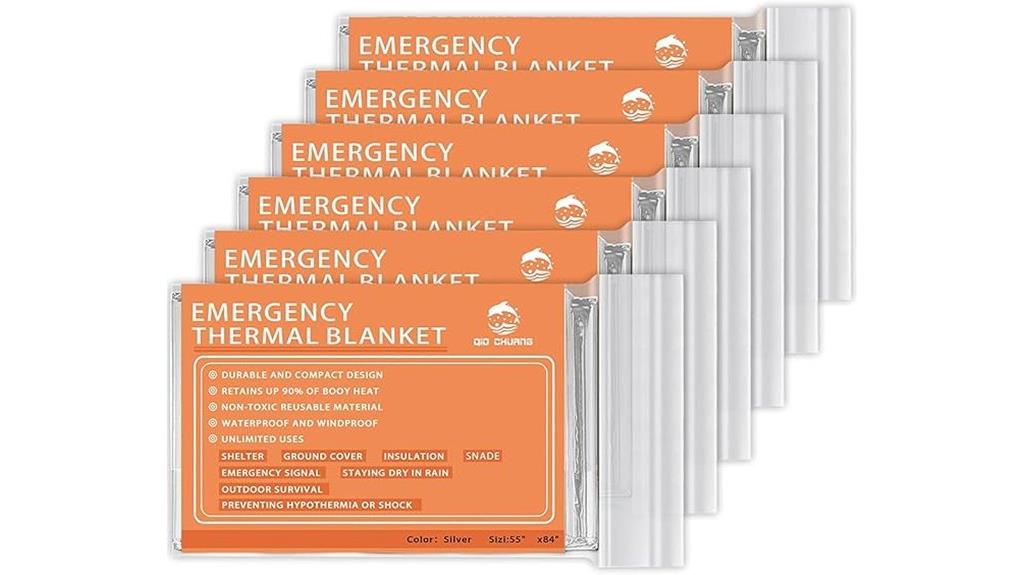
The Emergency Mylar Thermal Blankets (Pack of 6) are an ideal choice for anyone preparing for winter storms or outdoor emergencies, thanks to their ability to reflect up to 90% of body heat. Made from durable, aluminized Mylar, these blankets provide excellent insulation and help prevent hypothermia and shock. Waterproof and windproof, they can be used in wet, cold environments to stay dry and warm. Each blanket is individually folded and sealed, making them easy to store and quick to deploy when needed. Their versatility means you can use them as shelter components, ground covers, or emergency signals, making them a must-have for any survival kit.
Best For: outdoor enthusiasts, emergency preparedness kits, and anyone needing reliable thermal insulation in cold, wet conditions.
Pros:
- Reflects up to 90% of body heat, helping prevent hypothermia and shock
- Waterproof and windproof, suitable for all weather conditions
- Pack of 6 individually sealed blankets for easy storage and reuse
Cons:
- Can tear or puncture easily if not handled carefully
- Limited durability for long-term repeated use compared to more robust materials
- Single-use appearance may lead to disposal after initial deployment
Lifeline 4390 AAA Severe Weather Emergency Road Safety Kit

When preparing for winter storms, I look for a reliable roadside safety kit that can handle a variety of emergencies. The Lifeline 4390 AAA Severe Weather Emergency Road Safety Kit fits that need perfectly. It includes 66 essential pieces like a folding shovel, aluminum flashlight, emergency whistle, and a fleece set to keep you warm. The 45-piece first-aid pouch helps manage minor injuries, and the fire starter is handy if you need to generate warmth or signal for help. Endorsed by AAA, this kit is durable, compact, and designed to keep you safe and comfortable during winter roadside emergencies.
Best For: drivers preparing for winter storms and roadside emergencies who want a comprehensive, trusted safety kit endorsed by AAA.
Pros:
- Includes 66 essential safety and first-aid items designed for various emergency scenarios
- Endorsed by AAA, ensuring quality and reliability for roadside safety
- Compact and durable nylon exterior makes it easy to store and transport
Cons:
- The weight of 3.4 pounds may be slightly heavy for some users to carry easily
- The kit’s size (12.25 x 9 x 3.25 inches) might limit storage space in smaller vehicles
- Limited to basic emergency supplies; advanced or specialized tools are not included
Life Gear Emergency Food, Water & Thermal Blanket Kit

For anyone preparing for winter storms, the Life Gear Emergency Food, Water & Thermal Blanket Kit offers a reliable solution. This compact kit provides a three-day supply of US Coast Guard-approved food and water, each with a five-year shelf life, ensuring long-term availability. The thermal blanket can capture 80% of body heat, keeping you warmer in cold conditions. Its portability makes it easy to deploy in any situation—home, car, or outdoor. Designed for quick setup, it’s perfect as a standalone emergency item or to complement existing supplies. I recommend adding this kit to your preparedness plan for peace of mind during winter storms.
Best For: Individuals seeking a reliable, compact emergency preparedness kit for winter storms, outdoor adventures, or vehicle emergencies.
Pros:
- Approved by the US Coast Guard with a 5-year shelf life for food and water
- Thermal blanket captures 80% of body heat, providing excellent warmth in cold conditions
- Portable and easy to deploy in home, car, or outdoor environments
Cons:
- Designed for only one person, limiting its use for larger groups
- May require additional supplies for comprehensive emergency preparedness
- The kit’s contents are basic, possibly needing supplementation for extended emergencies
Emergency Survival Sleeping Bag for Camping and Outdoor Use
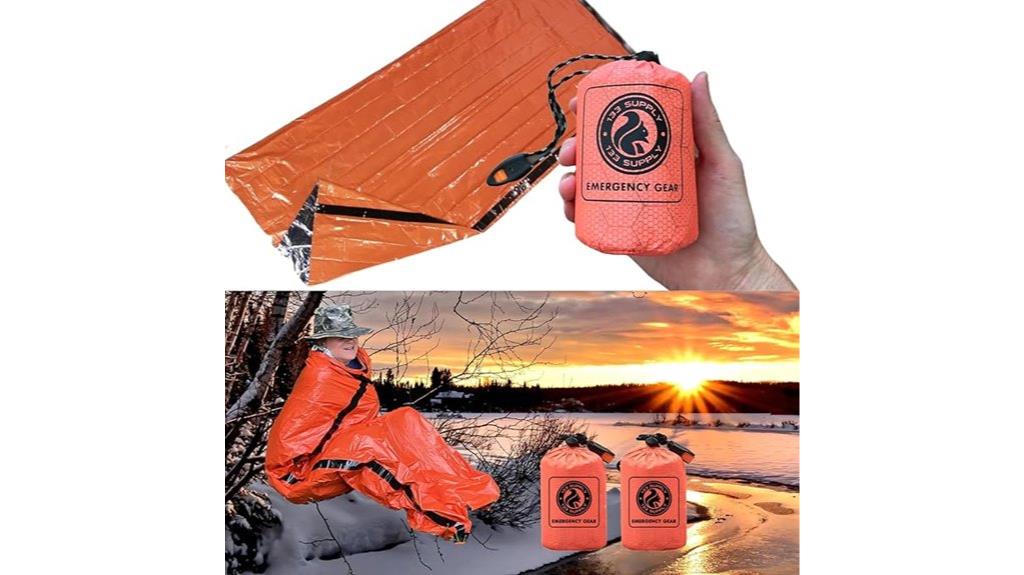
If you’re looking for a reliable way to stay warm during winter camping or emergency situations, an emergency survival sleeping bag is an essential tool. Made from extra thick 26um PE Mylar, it reflects 90% of body heat, helping prevent hypothermia. Its size—84×36 inches—fits most people and can even shelter two petite persons. Waterproof, tear-resistant, and versatile, it can be used as a sleeping bag liner, poncho, or emergency shelter. Compact and lightweight, it includes a survival whistle, paracord, and a waterproof sack, making it perfect for outdoor adventures, disaster prep, or car emergencies. It’s a practical addition to any survival kit.
Best For: outdoor enthusiasts, preppers, and emergency responders seeking reliable warmth and safety in cold or emergency situations.
Pros:
- Reflects 90% of body heat to prevent hypothermia effectively.
- Made from durable, tear-resistant Mylar material suitable for multiple uses.
- Includes essential survival tools like a whistle, paracord, and waterproof storage for portability.
Cons:
- May be bulky when packed compared to standard space blankets.
- Single-use or limited reusability due to material wear over time.
- Limited insulation compared to traditional sleeping bags, requiring layering for extreme cold.
First My Family 4-Person Emergency Survival Kit
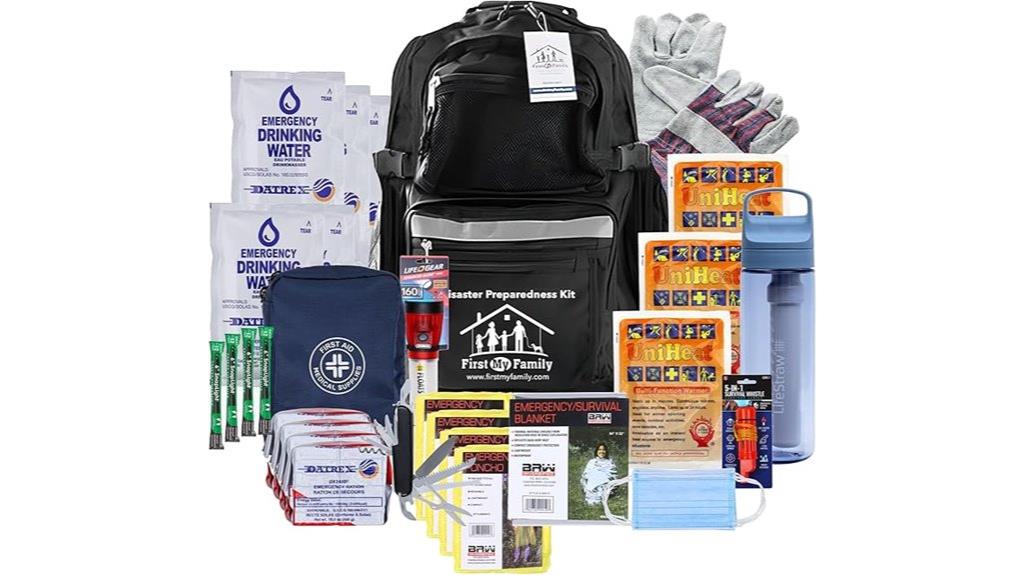
The First My Family 4-Person Emergency Survival Kit is an excellent choice for families seeking all-inclusive preparedness for winter storms and other disasters. It includes top-tier gear and supplies designed to support four family members through various emergencies, surpassing Red Cross standards. The 72-hour survival backpack is durable, waterproof, and easy to carry, offering essential provisions for three days. It features essential tools like a LifeStraw water filter, ensuring safe drinking water. This versatile kit not only provides peace of mind but also doubles as outdoor gear for camping or hikes, making it a practical investment for both emergencies and outdoor adventures.
Best For: families seeking comprehensive emergency preparedness and outdoor gear for natural disasters, camping, or hiking adventures.
Pros:
- Includes top-tier supplies exceeding Red Cross standards for added safety and reliability
- Durable, waterproof 72-hour backpack designed for easy transport and multiple outdoor uses
- Features essential tools like a LifeStraw water filter to ensure safe drinking water
Cons:
- May be bulkier or heavier than basic emergency kits, impacting portability for some users
- The comprehensive nature might include items some families do not need, potentially increasing cost
- Limited to four family members, requiring additional kits for larger families or groups
Go Time Gear Emergency Blankets (12 Pack)
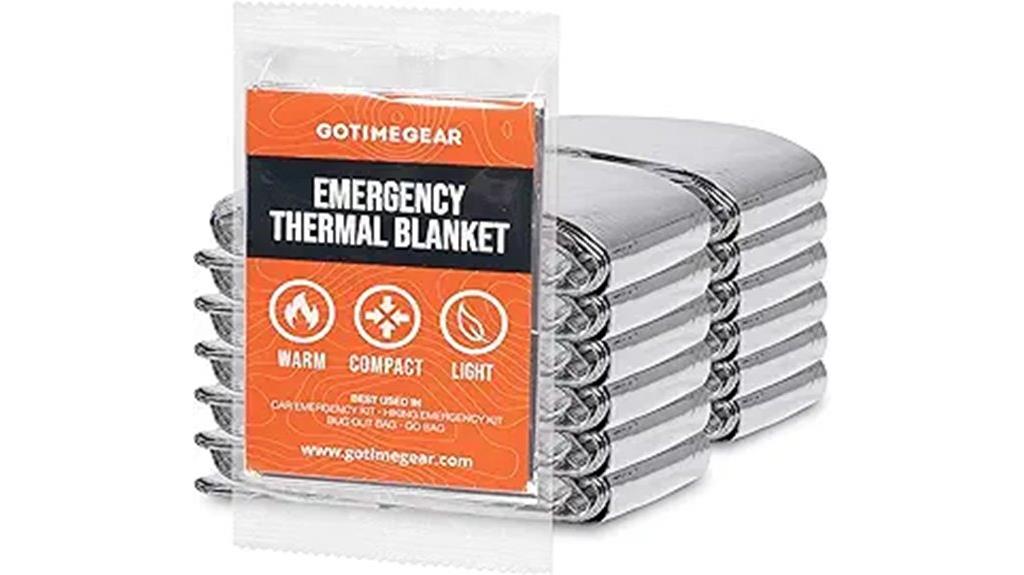
When preparing for winter storms, having reliable emergency blankets is vital, especially since Go Time Gear’s 12-pack offers a practical solution for multiple situations. These Mylar blankets reflect up to 90% of body heat, keeping you warm during outdoor or indoor emergencies. They’re lightweight, durable, and compact, making them easy to store in your survival kit or vehicle. Besides providing insulation, they can be used to signal rescuers or create solar stills to purify water. The 12-pack ensures you have enough for family, friends, or multiple emergency scenarios. Overall, these versatile blankets are an indispensable addition to any winter storm preparedness plan.
Best For: individuals and families preparing for winter storms, outdoor enthusiasts, and emergency responders seeking reliable, versatile survival gear.
Pros:
- Reflects up to 90% of body heat, providing excellent insulation during emergencies.
- Compact, lightweight, and durable, making storage and transportation easy.
- Multi-functional use as signaling devices and water purification tools enhances safety.
Cons:
- Single-use nature may lead to waste if not reused or recycled properly.
- May tear or puncture if handled roughly, reducing effectiveness.
- Limited insulation in extremely cold conditions without additional gear.
ReadyWise Emergency Food Supply (36 Buckets, 4320 Servings)
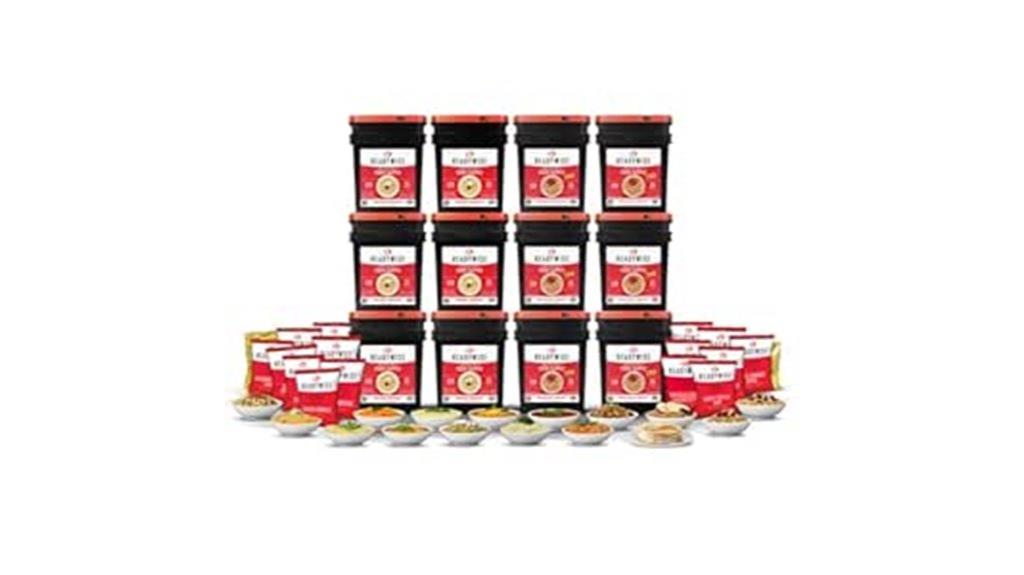
For those preparing for extended winter storms or uncertain power outages, the ReadyWise Emergency Food Supply offers a reliable solution with 36 buckets containing 4,320 servings of gourmet, long-lasting meals. Each bucket is designed for long-term storage with a shelf life of up to 25 years, ensuring your food stays fresh during emergencies. The stackable design makes storage easy and space-efficient, whether in a pantry or bug-out bag. With simple prep—just add water—meals like Cheesy Macaroni or Lasagna provide quick, nutritious sustenance. This versatile supply keeps you fueled during power outages, outdoor adventures, or any unexpected event.
Best For: individuals and families seeking a long-term, reliable emergency food supply for preparedness, outdoor adventures, or extended power outages.
Pros:
- Offers 4,320 servings across 36 durable, stackable buckets with up to 25-year shelf life.
- Easy to prepare—just add water—for quick, nutritious meals like Cheesy Macaroni and Lasagna.
- Compact, space-efficient design ideal for storage in pantries, backpacks, or bug-out bags.
Cons:
- The initial purchase may be costly due to the large quantity and long shelf life.
- Limited variety of meal options in the basic set; may require supplementing with additional foods.
- Bulk packaging may be inconvenient for small households or individual use.
Disaster-Ready Home Emergency Preparedness Manual
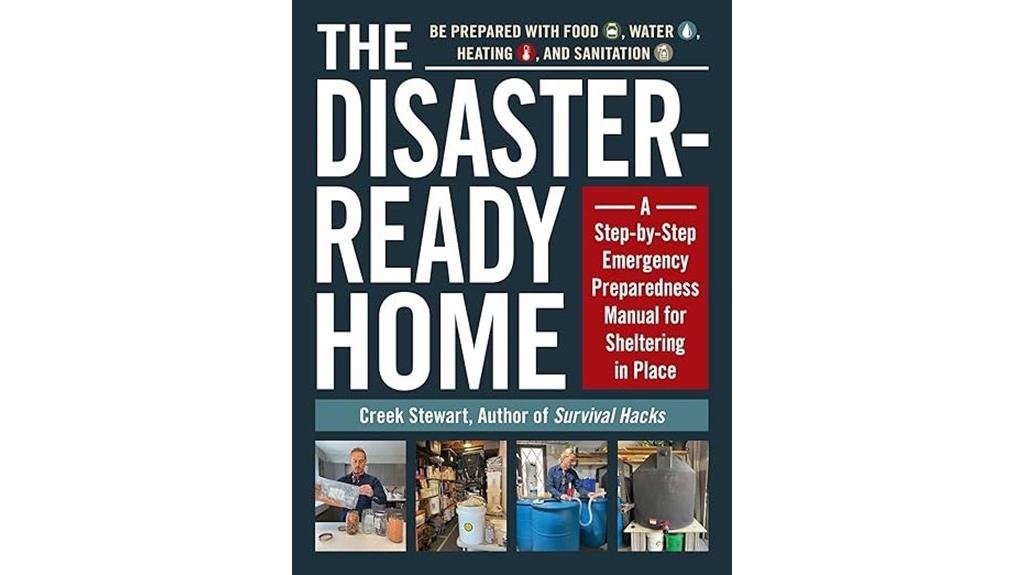
If you’re preparing your home for winter storms, the Disaster-Ready Home Emergency Preparedness Manual offers essential guidance on sheltering-in-place safely and comfortably. It covers creating a secure environment with necessary supplies, ensuring your family stays protected without needing to evacuate. The manual provides detailed strategies for storing enough food and water, preparing for extended outages, and maintaining sanitation when utilities fail. It also offers practical advice on heating, lighting, and cooking methods that work without power. Authored by survival expert Creek Stewart, this manual makes preparedness straightforward with step-by-step instructions, photos, and checklists, helping you confidently manage emergencies at home.
Best For: Homeowners and families seeking comprehensive, step-by-step guidance to prepare their homes for winter storms and other emergencies, ensuring safety and self-sufficiency during outages.
Pros:
- Provides detailed instructions with photos and checklists for easy implementation
- Covers a wide range of emergency preparedness topics including sheltering, food, water, heating, and sanitation
- Authored by experienced survival expert Creek Stewart, ensuring reliable and practical advice
Cons:
- May require purchasing additional supplies and equipment to fully implement recommendations
- Some readers might find the information overwhelming without prior preparedness knowledge
- Focused primarily on shelter-in-place scenarios, less guidance on evacuation procedures
Factors to Consider When Choosing a Winter Storm Emergency Supply List

When choosing your winter storm emergency supplies, I focus on key factors like enough food and water to last several days, warm clothing, and blankets to stay comfortable. I also consider reliable sources of power and light, along with communication devices to stay connected. Finally, I make sure I have essential survival tools and supplies to handle various situations safely.
Essential Food & Water
Choosing the right food and water supplies for a winter storm emergency is essential to stay safe and healthy. I recommend storing enough potable water to last at least three days per person, as FEMA suggests. Non-perishable, high-calorie foods like canned goods, energy bars, and freeze-dried meals with long shelf lives are ideal. Pick versatile options that need minimal prep and no refrigeration, especially if power goes out. It’s also smart to include water purification supplies, such as filters or tablets, to ensure safe drinking water if supplies run low. Finally, regularly check and rotate your stock to keep everything fresh and within expiration dates. Being prepared with the right food and water makes a big difference during winter storms.
Warm Clothing & Blankets
Ever wonder what factors are most important when selecting warm clothing and blankets for a winter storm emergency? The key is layering with thermal, waterproof, and wind-resistant clothing to stay warm in freezing temperatures. Insulated blankets or sleeping bags that reflect up to 90% of body heat are essential to prevent hypothermia. Prioritize moisture-wicking fabrics to keep you dry and wind-resistant materials to block cold gusts. It’s also smart to stock extra socks, hats, gloves, and scarves, as these help retain warmth during extended exposure. Choose durable, tear-resistant clothing designed for harsh winter conditions. These items will help you stay warm, dry, and protected, which is critical when emergency services are limited and cold exposure risks increase.
Reliable Power & Light
Reliable power and lighting are essential during winter storms because outages can happen unexpectedly, leaving you in the dark. I recommend having multiple alternative light sources like battery-powered flashlights, lanterns, or glow sticks, which are easy to access in emergencies. Using devices that operate independently of the electrical grid, such as hand-crank or solar-powered lights, guarantees you stay illuminated without relying solely on batteries. Always keep spare batteries, power banks, or portable chargers on hand to recharge essential devices when power is out. For longer outages, consider backup options like generators or fuel-powered lamps, but follow safety guidelines to avoid carbon monoxide risks. Storing these items in easily accessible locations guarantees quick access, helping you navigate safely in darkness or low visibility.
Emergency Communication Devices
When winter storms disrupt cell service and power, having the right emergency communication devices becomes essential for staying informed and connected. Battery-powered radios or NOAA weather alert radios are vital for receiving timely updates on storm conditions and safety alerts. Portable two-way radios allow communication between family members or team members if other channels fail or infrastructure is damaged. Solar or hand-crank chargers keep these devices powered without relying on electricity, which may be unavailable during outages. Signal mirrors, whistles, and flare kits provide visual and auditory signals to attract help if you’re stranded or lost. It’s also crucial to maintain fully charged backup power sources and extra batteries to ensure your communication tools stay operational during prolonged emergencies. Being prepared means staying connected, no matter the circumstances.
Survival Tools & Supplies
Having the right survival tools and supplies can make all the difference during a winter storm emergency. Durable shovels and ice scrapers are essential for clearing snow and maintaining access. Multi-tools help with repairs and emergency tasks, saving space and effort. Reliable light sources like flashlights, headlamps, and glow sticks are crucial when power goes out, guaranteeing visibility. First aid supplies, including bandages, antiseptics, and thermal blankets, are vital for treating injuries and preventing hypothermia. Signaling devices such as whistles, signal mirrors, and emergency flares increase your chances of rescue if you’re stranded. Additionally, water purification tools like portable filters and sealed containers guarantee access to safe drinking water. Choosing high-quality, versatile tools can considerably improve your safety and preparedness in winter emergencies.
Frequently Asked Questions
How Long Should My Emergency Supplies Last During a Winter Storm?
I recommend your emergency supplies should last at least three to seven days during a winter storm. I always prepare for the possibility of being snowed in, so I stock enough food, water, and batteries to cover that period. It’s better to have extra than run short, especially since power outages can extend unexpectedly. Planning for a week gives me peace of mind and guarantees I’m well-prepared for any situation.
Are There Specific Items Recommended for Infants or Elderly Family Members?
Yes, I recommend including specific items for infants and elderly family members. For infants, I pack formula, baby food, diapers, and extra blankets. For seniors, I make sure they have necessary medications, mobility aids, and warm clothing. I also keep a list of emergency contacts and medical info. It’s essential to tailor supplies to everyone’s needs, so I always double-check that my family’s essentials are well-stocked and accessible during winter storms.
How Often Should I Update or Rotate My Emergency Supplies?
I update my emergency supplies at least once a year, usually before winter storms hit. Think of it like giving your kit a much-needed tune-up—refreshing expired items and checking for damage. I also do a quick inventory after any use or if I notice anything looks off. Staying vigilant guarantees I’m prepared for anything, especially when a winter storm could turn into a real-life snow apocalypse.
What Are the Best Ways to Store Emergency Supplies to Prevent Damage?
To prevent damage, I store emergency supplies in a cool, dry, and easily accessible place, like a basement or closet. I use airtight containers for perishables and keep items off the ground to avoid moisture. Regularly checking for leaks or spoilage helps guarantee everything stays in good condition. Labeling containers makes it easy to find what I need quickly, especially during a winter storm emergency.
Can I Include Non-Food Items Like Entertainment or Comfort Items in My Kit?
Absolutely, you can include non-food items like entertainment or comfort items in your kit. I find that bringing books, puzzles, or cozy blankets helps keep spirits high during a winter storm. These items provide mental comfort and help pass the time. Just make sure they’re lightweight and don’t take up too much space. Prioritizing essentials is key, but a few comfort items can make a tough situation more bearable.
Conclusion
Preparing for a winter storm is like packing a safety net woven with care; each item a crucial thread securing your comfort and survival. As the snow blankets the world outside, imagine yourself wrapped in warmth and confidence, knowing you’re ready for whatever Mother Nature throws your way. Don’t wait for the storm to strike—build your emergency supply list today and turn winter’s chill into a manageable breeze. Your peace of mind is worth every effort.









